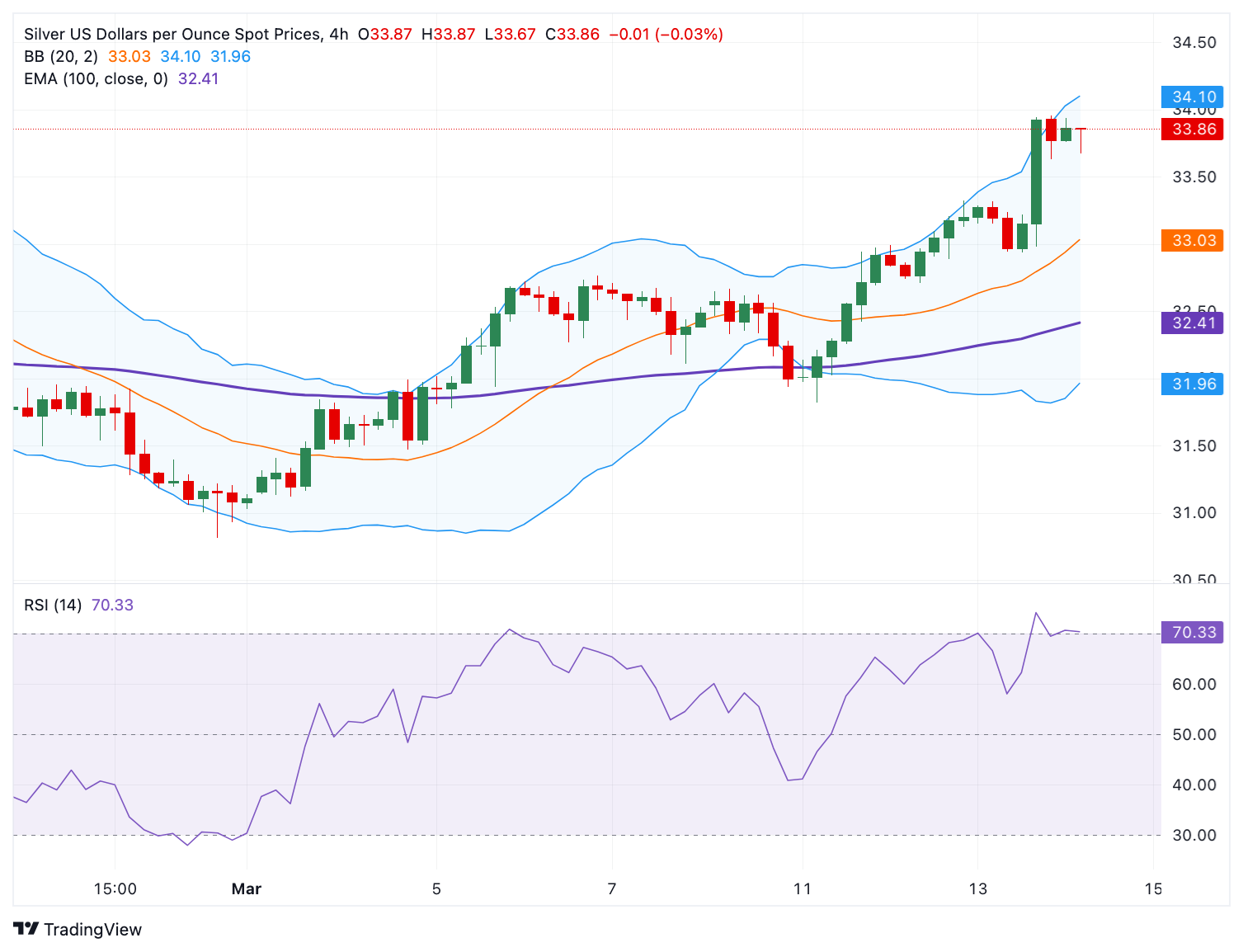- Analytics
- News and Tools
- Market News
- Silver Price Forecast: XAG/USD keeps the bullish vibe above $33.50 as trade war escalates
Silver Price Forecast: XAG/USD keeps the bullish vibe above $33.50 as trade war escalates
- Silver price drifts lower to $33.75 in Friday’s early Asian session.
- The positive bias of the metal prevails above the 100-period EMA, with the bullish RSI indicator.
- The key resistance level emerges at the $34.00-$34.10 region; the first downside target to watch is $32.94.
The Silver price (XAG/USD) loses momentum to near $33.80 during the early Asian session on Friday. However, the downside for white metal might be limited as the softer US consumer and producer inflationary pressures could pave the way for the Federal Reserve (Fed) to cut interest rates in the June policy meeting, which provides some support to the white metal.
Furthermore, the fear that protectionism from US President Donald Trump will push the United States, the world’s largest economy, into recession might contribute to Silver’s upside.
According to the 4-hour chart, the constructive outlook of the Silver price remains in play as the white metal holds above the key 100-period Exponential Moving Averages (EMA). Additionally, the Relative Strength Index (RSI) stands above the midline near 67.00, indicating bullish momentum. This suggests that further upside looks favorable for XAG/USD.
The crucial resistance level for Silver emerges in the $34.00-$34.10 zone, representing the psychological level and the upper boundary of the Bollinger Band. A decisive break above this level could see a rally to $34.55, the weekly high of October 28, en route to $34.87, the weekly high of October 21.
On the flip side, the initial support level is located at $32.94, the low of March 13. A breach of this level could expose $32.41, the 100-period EMA. Any follow-through selling below the mentioned level could see a drop to near $32.00, the lower limit of the Bollinger Band and round figure.
Silver price (XAG/USD) 4-hour chart

Silver FAQs
Silver is a precious metal highly traded among investors. It has been historically used as a store of value and a medium of exchange. Although less popular than Gold, traders may turn to Silver to diversify their investment portfolio, for its intrinsic value or as a potential hedge during high-inflation periods. Investors can buy physical Silver, in coins or in bars, or trade it through vehicles such as Exchange Traded Funds, which track its price on international markets.
Silver prices can move due to a wide range of factors. Geopolitical instability or fears of a deep recession can make Silver price escalate due to its safe-haven status, although to a lesser extent than Gold's. As a yieldless asset, Silver tends to rise with lower interest rates. Its moves also depend on how the US Dollar (USD) behaves as the asset is priced in dollars (XAG/USD). A strong Dollar tends to keep the price of Silver at bay, whereas a weaker Dollar is likely to propel prices up. Other factors such as investment demand, mining supply – Silver is much more abundant than Gold – and recycling rates can also affect prices.
Silver is widely used in industry, particularly in sectors such as electronics or solar energy, as it has one of the highest electric conductivity of all metals – more than Copper and Gold. A surge in demand can increase prices, while a decline tends to lower them. Dynamics in the US, Chinese and Indian economies can also contribute to price swings: for the US and particularly China, their big industrial sectors use Silver in various processes; in India, consumers’ demand for the precious metal for jewellery also plays a key role in setting prices.
Silver prices tend to follow Gold's moves. When Gold prices rise, Silver typically follows suit, as their status as safe-haven assets is similar. The Gold/Silver ratio, which shows the number of ounces of Silver needed to equal the value of one ounce of Gold, may help to determine the relative valuation between both metals. Some investors may consider a high ratio as an indicator that Silver is undervalued, or Gold is overvalued. On the contrary, a low ratio might suggest that Gold is undervalued relative to Silver.
© 2000-2025. All rights reserved.
This site is managed by Teletrade D.J. LLC 2351 LLC 2022 (Euro House, Richmond Hill Road, Kingstown, VC0100, St. Vincent and the Grenadines).
The information on this website is for informational purposes only and does not constitute any investment advice.
The company does not serve or provide services to customers who are residents of the US, Canada, Iran, The Democratic People's Republic of Korea, Yemen and FATF blacklisted countries.
Making transactions on financial markets with marginal financial instruments opens up wide possibilities and allows investors who are willing to take risks to earn high profits, carrying a potentially high risk of losses at the same time. Therefore you should responsibly approach the issue of choosing the appropriate investment strategy, taking the available resources into account, before starting trading.
Use of the information: full or partial use of materials from this website must always be referenced to TeleTrade as the source of information. Use of the materials on the Internet must be accompanied by a hyperlink to teletrade.org. Automatic import of materials and information from this website is prohibited.
Please contact our PR department if you have any questions or need assistance at pr@teletrade.global.















